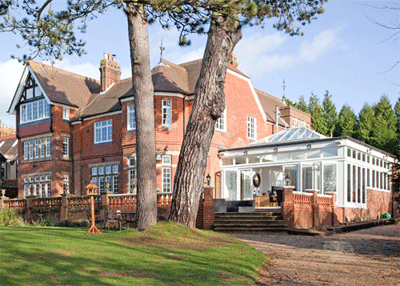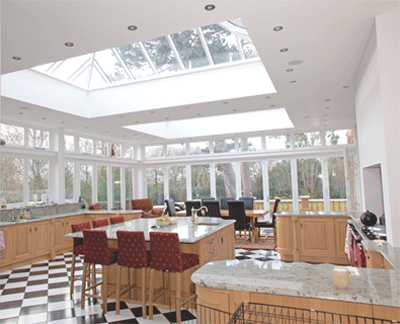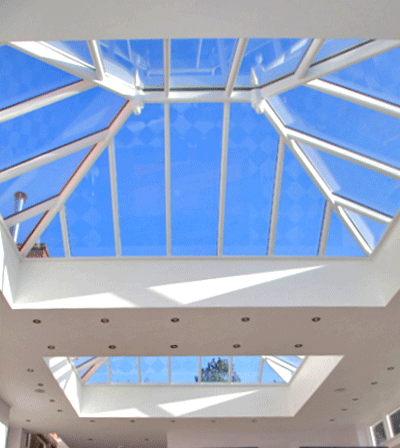Maximising natural light in your house
Making the most of natural light in your house saves money and is friendlier to the environment, not to mention making dark spaces much more conducive to work or relaxation

Light, spacious and airy living environments always seem to have a therapeutic effect, lifting our spirits and transforming our mood, just like a fantastic view from a window or a bright sunny morning. We have a natural human desire for the changes brought about by the seasons, the weather and the time of day and these sensory stimuli contribute to our general feeling of well being and happiness. For this reason, introducing as much natural light into your home as you can will improve your well-being.
The controlled use of natural lighting in architectural design, often referred to as daylighting, can reduce or eliminate the need for electric lighting in a working area or living environment. Clever design can offer considerable savings in energy costs whilst reducing carbon emissions and our individual carbon footprint. The most obvious method for daylighting in architectural design is via windows and doors but, in period properties in particular, the scope for alteration may be limited by design or planning restrictions.
However, there are clever alternatives available such as clerestories, skylights, light tubes, roof lanterns and bi-folding doors that can offer solutions for both restoration projects as well as new construction.
Historically, a clerestory is an architectural term that refers to the upper level of a Roman basilica or the nave of a Romanesque or Gothic church and describes a high wall with a band of narrow windows along the top, usually rising above the adjoining roofs. In modern terms, it refers to any high windows which are above eye level and can bring light and/or fresh air into an inner space where lower level windows are not feasible. This could be a useful feature where there are planning issues about windows overlooking adjoining properties and could be incorporated within existing properties as well as brick-built extensions.
A horizontal window placed on the roof of a building is referred to as a skylight and can include direct glazed windows, pivoting windows such as Velux style windows and roof lanterns or lantern lights. Direct glazed and pivoting windows are usually used on pitched roofs and are useful when converting an attic space for habitation especially where permission for a dormer window has been denied.
Where the roof is flat, an individually-constructed timber roof lantern will create a room which is bathed in natural light whilst providing a stunning architectural feature and dramatic views of the sky above. Terraced houses, by the nature of their design, are often starved of natural lighting as light is limited to the front and rear of the property and a flat roof extension combining both a roof lantern and bi-folding doors will introduce much needed natural lighting to otherwise dark and gloomy rooms.
Like modern versions of traditional orangeries, flat roofed garden and day rooms incorporating roof lanterns, windows and bi-folding doors are becoming increasingly popular additions to period homes and offices, providing additional living space for lounging, working, dining or cooking which is bathed in natural light.
Sign up for the Country Life Newsletter
Exquisite houses, the beauty of Nature, and how to get the most from your life, straight to your inbox.
Unlike their Victorian and modern day single glazed counterparts, these structures benefit from new glazing technology ensuring that they can be used throughout the year, remaining warm and dry during the winter and maintaining comfortable temperatures during the sunny summer months. In general, new extensions to historic and traditional buildings should comply with the standards of energy efficiency as set out in the current Building Regulations so they should be double glazed to ensure that valuable heat is not lost through the glass.
Modern solar control finishes reduce heat transfer from the sun and self cleaning properties ensure a maintenance free structure which is particularly valuable where access for cleaning is limited. When manufactured in timber with an aluminium dry glazing system to the exterior surfaces, a lantern offers the beauty of a natural product on the interior whilst providing a practical, maintenance free solution on the exterior which is guaranteed to be water tight, as opposed to the past when they used to leak!
A light tube or solar tube placed into a roof can admit light into an interior that's currently dark because it doesn't have direct access to the exterior surfaces of the building where windows or skylights could otherwise be fitted. From the transparent, roof mounted dome which collects the light, it is sent via a reflective coated tube to a diffuser which admits daylight into your once dark hallway or en-suite bathroom conversion, for example. Whilst not particularly attractive in their own right, they can reduce the need for electric lighting during daylight hours and create a more attractive ambience in a space that would otherwise be dark.

The owners of this large, detached property in East Sussex wanted to replace the existing small, dark and cramped kitchen within the property with a more spacious and light extension where they could entertain guests and enjoy their beautiful, mature garden in comfort despite the vagaries of the British weather.

They commissioned an extensive flat roof extension to house their kitchen and dining area which was designed with three, double hipped roof lanterns, a set of eight leaved, fully glazed bi-folding doors and one complete wall of windows for maximum light.

Whether you are restoring or planning an extension to your property, there are many creative ways to introduce or maximise the use of natural lighting whilst being sympathetic to the style of the existing building.
** NB Alterations and extensions to Listed Properties will always require Listed Building Consent from your local planning authority.
Located close to the historic town of Lewes in East Sussex, Parsons Joinery has built an excellent local reputation for quality joinery and efficient service. Our customer base beyond the local market includes West Sussex, Surrey Kent and London working for architects, designers, building contractors and private individuals. For more information, please visit www.parsonsjoinery.com
This is an article from ProjectBook which provides a wide range of information for the conservation, restoration, care and repair of period and listed buildings. Parsons Joinery are members of ProjectBook's Heritage Register which contains over 500 vetted craftsmen, contractors and consultants from all over the UK. Updated daily with new content, the website features the Heritage Register, a products directory, informative articles, current news, events and more. For more information, visit www.projectbook.co.uk.
Country Life is unlike any other magazine: the only glossy weekly on the newsstand and the only magazine that has been guest-edited by HRH The King not once, but twice. It is a celebration of modern rural life and all its diverse joys and pleasures — that was first published in Queen Victoria's Diamond Jubilee year. Our eclectic mixture of witty and informative content — from the most up-to-date property news and commentary and a coveted glimpse inside some of the UK's best houses and gardens, to gardening, the arts and interior design, written by experts in their field — still cannot be found in print or online, anywhere else.
-
 The King's favourite tea, conclave and spring flowers: Country Life Quiz of the Day, April 22, 2025
The King's favourite tea, conclave and spring flowers: Country Life Quiz of the Day, April 22, 2025Tuesday's Quiz of the Day blows smoke, tells the time and more.
By Toby Keel Published
-
 London is the place for me* (*the discerning property buyer)
London is the place for me* (*the discerning property buyer)With more buyers looking at London than anywhere else, is the 'race for space' finally over?
By Annabel Dixon Last updated
